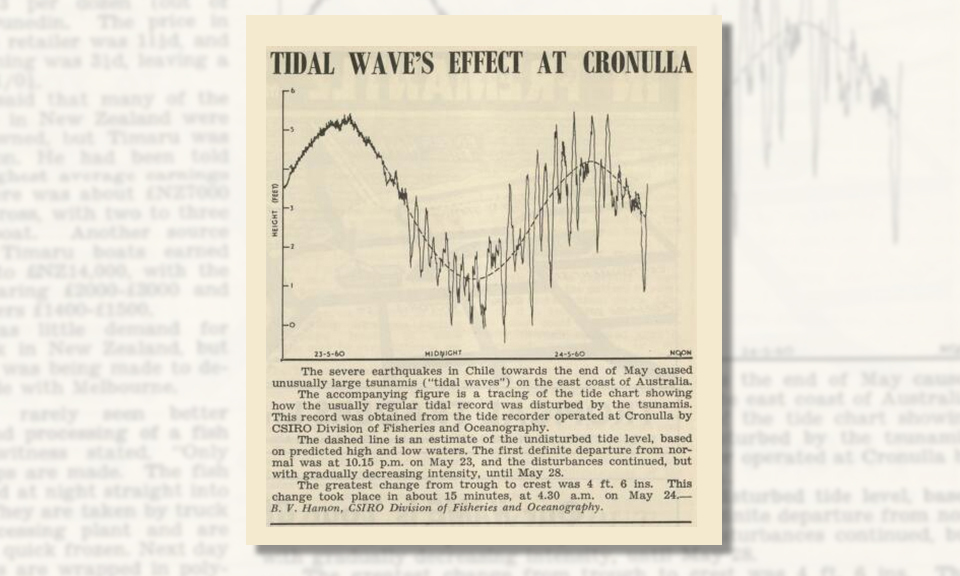Tsunami in Australia are rare, yet when they do occur, they pose a serious risk to our large coastal population. Looking at past events helps us understand how tsunami might impact Australia in the future. The 1960 Chile earthquake and subsequent tsunami events showed us just how far tsunami waves can travel, with waves reaching Australia from more than 11,000 kilometres away – a powerful reminder that although the chances are low, we need to be prepared.
Sixty years ago, at 7:11pm GMT on 22 May 1960, the most powerful earthquake ever recorded struck along Chile's southern coast. Estimates at the time registered the magnitude between 9.4 and 9.6 with a duration of about 10 minutes.
The earthquake triggered a series of tsunami, with waves reaching 25 metres high along the Chilean coast and travelling across the Pacific Ocean to Japan, Hawaii, the Philippines and Australia. The resulting waves were also recorded by tide gauges in the Atlantic and Indian Oceans making this the first global tsunami.
The global death toll and damages caused by the earthquake and tsunami are unknown, with estimates ranging from 1,000 to 7,000 lives lost, and damages equivalent to US$3.5-6.9 billion today.
This animation recreates the travel of tsunami waves across the Pacific Ocean. International figures taken from the National Ocean and Atmospheric Administration. New South Wales tide gauges recorded peak-to-trough waves between 0.4 and 1.7 metres, and observers reported waves up to 4.3 metres in isolated locations.
For Australia, this event showed us how far earthquake-induced tsunami can reach, with waves travelling more than 11,000 kilometres to Australia's east coast in just 14 hours. Abnormal tides were widely recorded along the south-east coast, with the effects being picked up by tide gauges as far as Cairns in north, Hobart in the south and Fremantle in the west. In New South Wales, tide gauges recorded peak-to-trough waves up to 1.7 metres with observers reporting waves of 3–4.3 metres in some estuaries and isolated locations.

An Australian Fisheries Newsletter clipping from 1960 shows the changes in wave heights recorded at Cronulla, New South Wales. Image source: CSIRO Marine Laboratories - Fisheries Newsletter: Volume 19, July 1960.
Geoscience Australia's Head of Community Safety Branch, Leesa Carson, said that while the impacts from the 1960 Chile earthquake and tsunami were minor in Australia compared to other countries, this event is a stark reminder that earthquakes and tsunami occur suddenly, at any time, and cause considerable damage.
"If the 1960 Chile earthquake occurred a few thousand kilometres further north, the tsunami impact to Australia could have been much worse," Ms Carson said.
"Tsunami from anywhere across the Indian and Pacific Oceans have the potential to impact Australia.
"The 1960 events showed us how big earthquakes can get – and how far waves can travel. Knowing this information helps us identify which places in Australia are most likely to be impacted by tsunami, even from earthquakes that may occur as far away as South America or the Middle East."
This historic event provided important insights and data which continue to help inform today's tsunami modelling. Geoscience Australia's Probabilistic Tsunami Hazard Assessment (PTHA) tool uses data from past tsunami and earthquake events – including the 1960 Chile events – to predict the likelihood of different sized tsunami occurring around the Australian coast.
The PTHA is based on the behaviour of tsunamis caused by subduction earthquakes in the Indian and Pacific Oceans – the most common cause of tsunami in the Australian region.

Geoscience Australia's Probabilistic Tsunami Hazard Assessment tool uses data from historic events to help Australia prepare for future tsunami hazards.
When combined with local topography and near-shore bathymetry data, the PTHA allows users to create scenarios to assess the impacts that tsunami could have in their region.
"Geoscience Australia works with all levels of governments and emergency services to help them use the PTHA to inform their decisions, planning and emergency procedures," Ms Carson said.
"This nationally-consistent approach helps Australia understand and prepare for future tsunami hazards, which we know from 1960 can have devastating impacts on countries from very long distances.
"Fortunately for us, tsunami are rare in Australia, but if an alert is raised, it's important to take it seriously."
The Joint Australian Tsunami Warning Centre identifies tsunami threats from earthquake sources and determines how serious they are for relevant coastal zones around Australia. Tsunami warnings are issued to the public by the Bureau of Meteorology via radio, television, 1300 TSUNAMI or www.bom.gov.au/tsunami.
If a tsunami warning is raised in your area, listen and respond to your local emergency services.
Geoscience Australia helps Australia prepare for hazards such as tsunami. We provide authoritative, independent information and advice to the Australian Government and maintain and improve systems for effective natural disaster preparedness, response and recovery.






